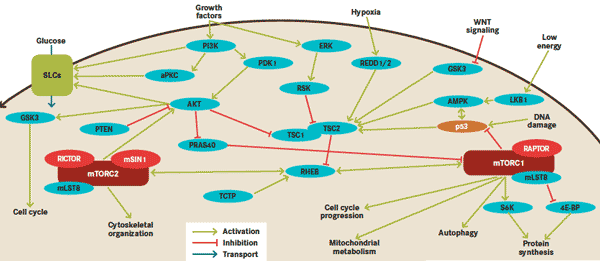Publication
Article
Oncology Live®
A Tale of 2 Complexes: The mTOR Signaling Pathway in Cancer Development
Author(s):
The mammalian target of rapamycin (mTOR) is a master switch, central regulator, or key integrator of cell growth and proliferation
5 Questions for David M. Sabatini

David M. Sabatini, MD. PhD, is a principal investigator at the Sabatini Lab at the Whitehead Institute for Biomedical Research and associate professor of biology at Massachusetts Institute of Technology (MIT). His research into the mTOR pathway has led to the identification of numerous components of this pathway, as well as its cellular and organismal functions. He is a recipient of the 2009 Paul Marks Prize for Cancer Research, among numerous other distinctions.
What role does mTOR signaling play in normal cells?
In normal cells, mTOR is essential for cells to generate and accumulate mass, and therefore grow (ie, increase in size). It is one of the central growth-promoting pathways in all cells.
How important is it in cancer development?
mTOR is also a key growth regulator in cancer cells. In addition, there are many cancer-causing mutations (in tumor suppressors and oncogenes) that lead to mTOR activation—so that it is estimated that 60% to 80% of tumors have hyperactive mTOR signaling.
Are there any currently available mTOR-targeted treatments?
Yes. The best-known mTOR inhibitor is a molecule called rapamycin, and there are also derivatives of rapamycin that are in clinical use. These molecules are used as immunosuppressants, blockers of coronary vessel restenosis in drug-eluting stents, and as treatments for cancer. They also have potential uses in neurodegenerative diseases.
Which components of the mTOR pathway do they target?
They all target the mTOR kinase, which is the central component of the pathway. They are allosteric inhibitors of mTOR.
What is the future for mTOR signaling in cancer research?
The key will be to identify which cancers are particularly sensitive to mTOR inhibitors. Currently, we know that many cancers exhibit mTOR hyperactivation, but not all respond equally to mTOR inhibitors. What is most needed is the identification of a cancer-specific mutation that causes cancers to be addicted to mTOR activity.
The wealth of literature describing the mammalian target of rapamycin (mTOR) features a common analogy: that mTOR is a “master switch,” “central regulator,” or “key integrator” of cell growth and proliferation. Therefore, it is unsurprising to find that aberrant mTOR signaling is implicated in the pathogenesis of cancer and has attracted substantial interest from researchers since its discovery 20 years ago.
The mTOR Complexes
mTOR is a serine/threonine kinase that exists in 2 multiprotein complexes, mTORC1 and mTORC2, defined by the different component proteins bound to mTOR. Both complexes consist of mTOR and the mLST8 and Deptor proteins. mTORC1 also contains the regulatory-associated protein of mTOR (Raptor) and the proline-rich Akt substrate of 40kDa (PRAS40) protein. mTORC2 contains the rapamycin-insensitive companion of mTOR (Rictor), mammalian stress-activated kinase-interacting protein 1 (mSin1), and the protein Protor.
Rapamycin, available since the mid-1970s, is a naturally occurring inhibitor originally isolated from a strain of the soil bacterium Streptomyces hygroscopicus and was initially used as an immunosuppressive drug. The discovery of 2 yeast genes, TOR1 and TOR2, led to the identification and cloning of mTOR. And, once mTOR was implicated in cancer, researchers turned their attention to the role of rapamycin in cancer development.
The exact mechanism of rapamycin inhibition remains unclear; it forms a complex with FKBP12 (FK506-binding protein of 12kDa) and mTOR. It is believed that only mTORC1 is infl uenced by rapamycin. However, recent evidence suggests that mTORC2 may also be susceptible to prolonged rapamycin exposure.
mTOR Pathway Activators and Effectors
Conserved from yeast to man, mTOR integrates incoming signals from nutrient and energy sensors on the cell surface with activation of cellular machinery to regulate growth and proliferation, ensuring that these processes happen only under appropriate conditions. mTOR receives signaling input from growth factors, hormones (eg, insulin), nutrients (eg, amino acids), cellular energy levels, and stress conditions.
A principal signaling pathway that activates mTORC1 is the phosphatidylinositol 3-kinase/ protein kinase B (PI3K/Akt) pathway, which is well known for its central role in cell survival and proliferation. In the context of mTOR signaling, activated Akt phosphorylates and inhibits the tuberous sclerosis complex (TSC) and PRAS40, both of which are negative regulators of mTORC1, thereby activating mTORC1.
Notably, mTORC1 can also be activated via AMPactivated serine/threonine protein kinase (AMPK), a sensor of cellular energy status. The activation of mTORC2 is understood to a far lesser degree, but it is believed to occur exclusively in response to growth factors.
The best characterized targets of mTOR signaling are ribosomal protein S6 kinase 1 (S6K1) and eukaryotic initiation factor 4E-binding protein 1 (4EBP1), both of which regulate protein synthesis. However, mTOR activates a vast range of proteins that regulate many of the “hallmarks of cancer” described by Robert Weinberg in his landmark Cell article in 2000, including cell division, angiogenesis, and cell survival.
mTOR Signaling and Cancer
Surprisingly, a direct involvement of mTOR in cancer development has yet to be proven. Researchers have been unable to identify any cancer-driving mutations in the TOR gene, and it is still unclear whether aberrant mTOR activation is required for cancer initiation.
What is clear is the indirect involvement of mTOR signaling in a plethora of different cancers, via overexpression or loss of upstream activators, downstream targets, and regulators of mTOR activity. The main culprits leading to aberrant mTOR signaling include mutations in PI3K, overexpression of Akt, overexpression or mutation of the TSC complex, many receptor tyrosine kinases, and the mTOR target proteins S6K1 and 4EBP1. In addition, the loss of function of the phosphatase and homolog tensin gene (PTEN) counteracts PI3K function; it is among the most commonly inactivated tumor-suppressor genes in human cancers.
Overall, aberrant mTOR signaling is estimated to be activated in 60% to 80% of gastric adenocarcinomas, 25% to 45% of hepatocellular carcinomas, and numerous other tumor types, including HER2-positive breast cancer, non-Hodgkin lymphoma, colon cancer, and prostate cancer.
mTOR Inhibition: Something Old, Something New
Currently, there are 2 mTOR inhibitors approved by the FDA, both of which are analogs of rapamycin (dubbed rapalogs). They are everolimus (Afinitor), an oral agent dosed once per day, and temsirolimus (Torisel), administered intravenously once per week. Both are approved for the treatment of renal cell carcinoma (RCC): everolimus for refractory, advanced RCC after failed treatment with the receptor tyrosine kinase inhibitors sorafenib (Nexavar) and sunitinib, (Sutent) and temsirolimus for poorprognosis, untreated RCC. In Europe, temsirolimus is also approved for refractory mantle cell lymphoma (MCL) and a third rapalog, ridaforolimus, is approved for RCC.
Clinical trials of rapalogs are ongoing in a variety of different tumors as single agents and in combination with other therapies. However, despite promising improvements in progression-free survival, overall survival, and overall response rate in RCC and MCL, rapalogs have proven only modestly successful in many clinical trials. In part this reflects the fact that rapalogs do not effectively inhibit mTORC2 and an incomplete understanding of the functions of mTOR and the complex feedback loops in its signaling network. Particularly relevant in respect to the latter is a recently identified negative feedback effect on the PI3K/Akt pathway, suggesting that inhibition of mTOR may inadvertently activate this pathway, thereby promoting growth and survival.

This illustration depicts a simplified scheme of the mTOR signal transduction pathway
Campa D, Hüsing A, Stein A, et al. Genetic variability of the mTOR pathway and prostate cancer risk in the European prospective investigation on cancer (EPIC). PLoS ONE 6(2): e16914. doi:10.1371/journal.pone.0016914.
In response to the deficiencies of the rapalogs, a second generation of smarter compounds is being developed. Among them are specifi c mTOR inhibitors that target the kinase activity of both mTORC1 and mTORC2, including WYE354 and WYE132 (Pfi zer), PP30 and PP242 (Intellikine), AZD8055 (AstraZeneca), OSI-027 (OSI Pharmaceuticals), and Torin1. These inhibitors have been shown to induce more potent and durable inhibition of mTOR.
In order to circumvent the activation of feedback loops that may preclude tumor responsiveness to mTOR inhibition, dual inhibitors of mTOR/PI3K have also been developed, including BEZ235 (Novartis), XL765 (Exelixis), GDC-0980 (Genentech), PF-04691502 (Pfizer), and PF- 05212384 (Pfi zer). All of these second-generation agents are currently undergoing phase I and II clinical testing in solid tumors and a variety of other cancers.
Finally, given the unpredictable response to rapalog treatment, the development and validation of molecular biomarkers will be crucial in determining which patients will benefi t. Since 2000, major efforts have been directed toward achieving this end. A number of putative predictors have been identified in preclinical models, but are not yet fully validated in the clinic.
Key Research
- Borders EB, Bivona C, Medina PJ. Mammalian target of rapamycin: biological function and target for novel anticancer agents. Am J Health-Syst Pharm. 2010;67(24):2095-2106.
- Dancey JE. Inhibitors of the mammalian target of rapamycin. Expert Opinion Investig Drugs 2005;14(3):313-328.
- Efeyan A, Sabatini DM. mTOR and cancer: many loops in one pathway. Curr Opinion Cell Biology. 2010;22:169-176.
- Faivre S, Kroemer G, Raymond E. Current development of mTOR inhibitors as anticancer agents. Nat Rev Drug Discovery. 2006;5:671- 688.
- Guertin DA, Sabatini DM. Defi ning the role of mTOR in cancer. Cancer Cell Rev. 2007;12:9-22.
- Guertin DA, Sabatini DM. The pharmacology of mTOR inhibition. Sci Signaling. 2009; 2(67):1-6.
- Hay N, Sonenberg N. Upstream and downstream of mTOR. Genes Dev. 2004;18:1926-1945.
- Vilar E, Perez-Garcia J, Tabernero J. Pushing the envelope in the mTOR pathway: the second generation of inhibitors. Mol Cancer Ther. 2011;10:395-403.
- Wander SA, Hennessey BT, Slingerland JM. Next-generation mTOR inhibitors in clinical oncology: how pathway complexity informs therapeutic strategy. J Clin Invest. 2011; 121(4):1231-1241.
- Yuan R, Kay A, Berg WJ, Lebwohl D. Targeting tumorigenesis: development and use of mTOR inhibitors in cancer therapy. J Hematol Oncol. 2009; 2(45):1-12.


























%20(2)%201-Recovered-Recovered-Recovered-Recovered-Recovered-Recovered-Recovered-Recovered-Recovered-Recovered-Recovered-Recovered-Recovered-Recovered-Recovered-Recovered-Recovered.jpg?fit=crop&auto=format)
%20(2)%201-Recovered-Recovered-Recovered-Recovered-Recovered-Recovered-Recovered-Recovered-Recovered-Recovered-Recovered-Recovered-Recovered-Recovered-Recovered-Recovered-Recovered.jpg?fit=crop&auto=format)
